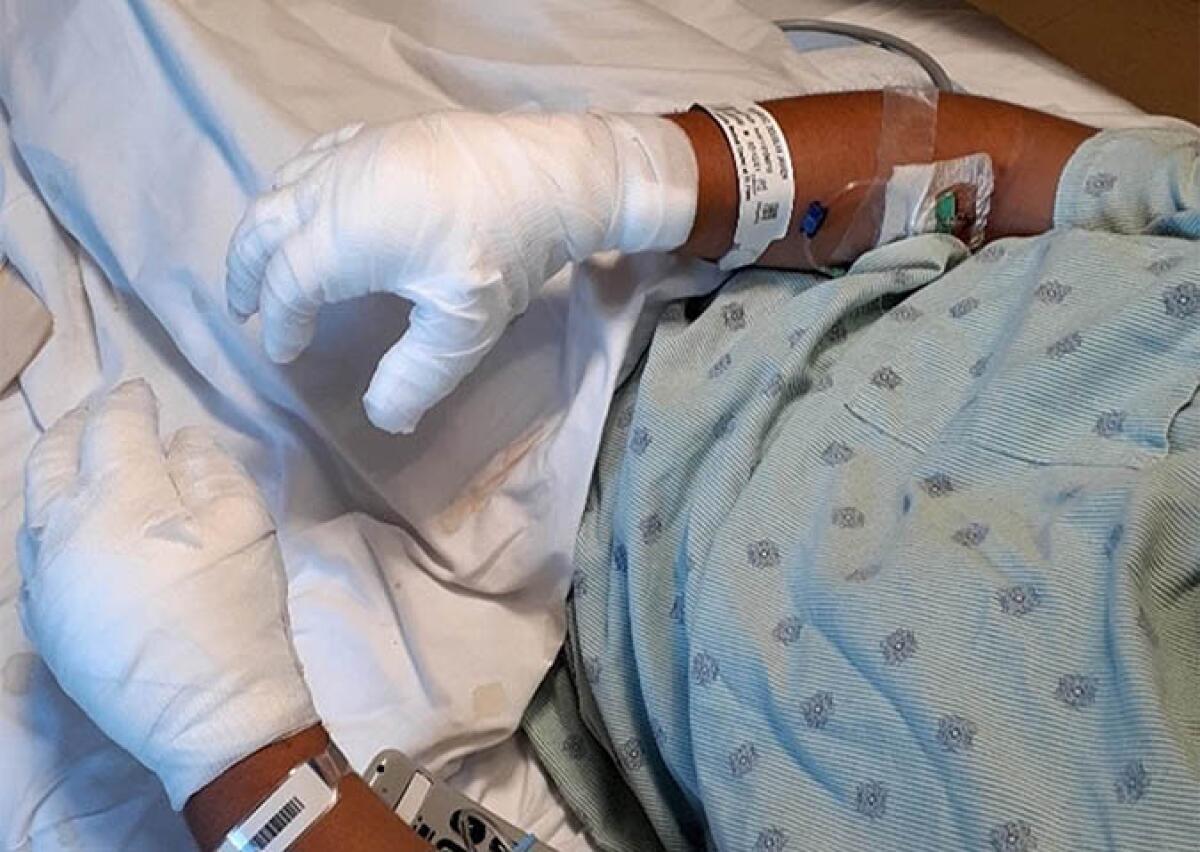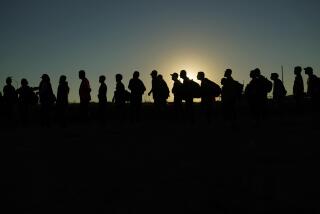How a Guatemalan asylum seeker who may lose both hands to Texas frostbite tests Biden’s immigration policy

Douglas couldn’t see anything — the snow was falling so fast, and there was no light.
The smuggler was long gone; though Douglas yelled and yelled, no one came. The 21-year-old and a dozen other migrants already had been wandering in the desolate desert landscape around Van Horn, Texas, for two days when the snowstorm began.
When he heard cries for help off in the distance, Douglas left the others and set off in the dark to try and find a man who’d become separated from the group. He came upon the older man and put his arm over his shoulder, dragging him through the snow until he finally stumbled on a road and couldn’t go any farther, he said.
Douglas had left Guatemala a week and a half earlier, fleeing threats from gangs and hoping desperately to join his father in California, whom he hadn’t seen for more than five years, when he got caught in the historic winter storm that devastated Texas recently.
He’d never seen snow before.
“I wanted to die,” he said, asking that only his first name be used out of concern for his safety.
Then, out of the blackness, he heard officials telling him: “Open your eyes, open your eyes.”
When he finally could open them, he was in a hospital bed in El Paso, about 110 miles from where he was found unconscious. What he saw were his frostbitten hands: swollen to the size of baseball gloves; fingers lumpy and gray; oozing, raw skin seemingly ready to fall off in chunks.
Healthcare workers at the University Medical Center of El Paso told Douglas’ lawyer and his uncle Joel, who’d traveled from San Francisco, that his hands probably need to be amputated.
But border agents, stationed at his hospital room while he is in their custody, said Douglas would be sent back to Guatemala once he was discharged. A Trump-era policy in effect closed the U.S.-Mexico border to asylum seekers almost a year ago, purportedly to help stem the spread of COVID-19. President Biden has kept the controversial policy, known as Title 42, in place.
“There is no asylum anymore,” Douglas said the Border Patrol agents stationed at his room told him.
Linda Corchado, Douglas’ lawyer and director of legal services at Las Américas Immigrant Advocacy Center in El Paso, said that a deputy chief counsel for Customs and Border Protection, the Border Patrol’s parent agency, told her late Thursday that they’d agreed to release him to join his father after being discharged from the hospital.
But as of Friday, his uncle Joel said, agents still were telling him he could not take his nephew, who would be removed from the country. Joel asked to use only his first name to protect against retaliation because he does not have legal status.
“I told them we wanted to take him back to California and see if we could save his fingers.… They told me he had a deportation order and no right to anything,” Joel said. “I asked them to act with a little humanity.”
The White House referred The Times to CBP and the Homeland Security Department. University Medical Center did not respond.
Late Friday, after this article was first published, Homeland Security officials contacted Corchado and confirmed that Douglas would not be expelled under Title 42 but instead processed under Title 8, which allows for asylum claims, and would be issued a notice to appear in immigration court.
Justin Long, a CBP spokesman, said late Saturday that the agency would not comment on specific cases, but “the care of those in our custody is of the utmost concern.” Title 42, he said, remains in place, and “Any changes in the [Centers for Disease Control and Prevention] order are controlled by that agency.”
Late Sunday, still in the hospital, Douglas received immigration papers allowing for his release from CBP custody to California when he is discharged.
The president and First Lady Jill Biden traveled Friday to Texas as the state grapples with the damage of the storm, which killed nearly 80 people there — including at least four migrants, according to Border Patrol — though it may take months to determine the final death toll.
Under Title 42, border officials have rapidly expelled hundreds of thousands of migrants, including asylum seekers and unaccompanied children, without due process. Officials with the CDC said the Trump administration pushed the order for political reasons, and that it did little to stem the spread of COVID-19.
At the border, the Biden administration has restarted asylum processing for the first of some 70,000 forced back to Mexico under President Trump’s “Remain in Mexico” policy. The new program was initiated Feb. 18 at San Ysidro for the roughly 26,000 who still have active cases in U.S. immigration courts; on Friday, it was expanded to El Paso. And in Washington, the administration has been lobbying for a comprehensive immigration reform bill that would offer a path to citizenship to some 14 million immigrants already in the United States as of Jan. 1.
But officials argue that Title 42 remains necessary and will stay in place, in part to discourage a surge in migrants at the U.S. southern border amid the pandemic.
Still, each day hundreds of migrants like Douglas, mostly families from Central America, are crossing the Rio Grande and being allowed into Texas and sent onward to their families to await court hearings — to the exasperation of tens of thousands of others at the border who in some cases have waited years to enter the United States the “right way,” and been left stranded in Biden’s first month.
Biden officials urge patience, saying that the more than 1,000 actions Trump took to restrict immigration cannot be undone quickly. But the situation is urgent for Douglas, who says he fears both losing his hands and being sent back to Guatemala to be killed. Yet it’s not the first time the U.S. government has trapped him in policy limbo.
A June 6, 2017, letter from the U.S. Citizenship and Immigration Services’ Refugee Affairs Division, reviewed by The Times, informs his father and stepmother in California that Douglas was approved for the Obama-era Central American Minors parole program, and would be scheduled for an interview.
The program begun by President Obama enabled endangered Central American minors to apply to join parents in the United States. And in one of Trump’s first moves in office, he suddenly axed the program, stranding more than 2,700 children approved and in processing, according to one Biden official — including Douglas.
“Donald Trump took the presidency and there was no more contact,” Douglas said from his hospital bed. He decided to come himself. “I couldn’t be in Guatemala anymore.”
Earlier this month, Biden issued an executive order to take steps to restore the program, though there’s no signs of it yet. Almost four years later, it is too late for Douglas.
At the same time as Biden officials have instructed immigration enforcement agencies that border crossers should be regarded as “security threats,” they say they are not violating U.S. law that grants migrants the right to seek asylum however they enter, whether at ports of entry or between them.
“Individuals can still claim asylum,” one Homeland Security official said on a media call, speaking on condition of anonymity without providing a reason.
Lawyers who sued the Trump administration over Title 42 have said it violates a range of U.S. laws.
“There’s no question that the Title 42 policy is unlawful,” Lee Gelernt, of the American Civil Liberties Union, whose suit now faces the Biden administration, told The Times.
Critics say the Biden administration’s delay and the confusion it has created at the border and beyond have resulted in cruelly arbitrary consequences for migrants such as Douglas, with border officials who themselves have differing understandings of — and training on — the latest policy shifts seeming to apply them differently from one often life-or-death decision to the next.
Corchado, who is representing several clients hospitalized after crossing during the storm, as well as others quickly expelled by Border Patrol despite serious injuries falling from the border barrier, said, “CBP is being inconsistent with how they’re treating these cases.”
For some, she said, “They’ll just say, ‘OK, you’re expelled,’ with little way for me to intervene or know what’s going on.”
Of the group of migrants caught in the recent blizzard — Douglas said there were 14 men and two women of varying ages — he still does not know who survived, including the man he tried to save.
When he crossed the border, he was not wearing winter clothes and had no gloves — the coyote had given them no warning about the coming weather. Douglas has “deep” frostbite in both hands and ears, and one foot, according to hospital records obtained by The Times.
“21-year-old male who was found after being in the snow for 15 hours,” states one report, dated Feb. 15, the day Douglas arrived. “He was with multiple other people who passed away from frostbite.”
A day later, a “progress report” states, “Ortho consult in AM anticipating need for eventual amputation.”
Border Patrol agents rescued more than 200 people during the storm, and at least four died before they were found, according to a news release from the agency’s Big Bend sector, where Douglas was picked up.
“It’s unfortunate so many people place their lives in the hands of unscrupulous smugglers, which often results in a tragic situation like this,” Big Bend Sector Chief Patrol Agent Sean McGoffin said in the release.
CBP did not respond to requests for comment about how many rescued in the storm were released into the United States, or expelled.
Agents have told The Times that a combination of new sections of 30-foot barrier constructed under Trump and Title 42 is pushing migrants to cross in more remote and dangerous areas, as well as to repeat attempts.
From October through February, Border Patrol has conducted nearly 3,000 search and rescue operations — on pace to more than double the number of such operations last fiscal year, and far exceed 2019, which saw among the highest levels of migration to the border than seen in decades.
Corchado is also representing an Indigenous couple from Guatemala who were caught in the winter weather and brought to the same hospital as Douglas, having nearly died from hypothermia. Their home was destroyed in recent hurricanes that slammed the Northern Triangle.
In the hospital, the husband kept describing over and over how his wife told him she couldn’t feel her heartbeat anymore, instructing him on how she wanted their kids to be raised, Corchado said. Both tested positive for COVID-19.
At first, CBP officials indicated to the couple that they could be expelled under Title 42 once discharged. But late Wednesday, without notice to Corchado, the hospital released them, and Border Patrol detained them. A CBP supervisor said Thursday that they wouldn’t be expelled and their asylum claims would be considered, according to communications shared with The Times.
When reached by phone Saturday from CBP detention, the husband told Corchado that after they were discharged from the hospital on Wednesday, Border Patrol agents began to walk them across the border without shoes, when an agent received a call over the radio, stopped, and detained them instead.
CBP officials told Corchado that the wife was released from the agency’s custody Saturday morning and is now being held by Immigration and Customs Enforcement. On Sunday, CBP transferred the husband to ICE as well.
On a Feb. 18 call with advocates and lawyers, Homeland Security Secretary Alejandro N. Mayorkas grew frustrated when asked about other cases in which border authorities expelled injured migrants under Title 42 despite some being unable to walk after falling off the wall, according to Corchado, who was on the call.
“He was just appalled that people are jumping the wall,” Corchado said. “The point is with Title 42, that’s what happens … people are getting more and more desperate.”
Douglas’ mother and grandmother didn’t want him to make the dangerous journey north, but they didn’t want him killed either, he said. The family paid a smuggler $2,000, and around Feb. 13, Douglas crossed the Rio Grande from Chihuahua, Mexico.
Joel said he didn’t know his nephew was making the journey until he was told that authorities were searching for him.
“I would have advised him not to do it, for everything I lived through when I came here,” he said.
Douglas’ father, who does not have legal status in the United States, feared coming to the Texas hospital where border authorities held his son in custody, so Joel, who says he has a state ID issued by California and permission to work, came instead. Joel said Border Patrol prevented him from seeing his nephew for days, only allowing him into the hospital room late Wednesday night. He said both of them cried.
“It was the helplessness of already no longer being able to do anything for him, and lamenting that his trip and all that he had spent for it was in vain,” he said.
Joel was supposed to return to San Francisco late Friday, having been given only a week off work at a hotel. For now, he’s staying in El Paso with his nephew, waiting for when Douglas is discharged.
“My only thought was to see my dad — it’s the only thing that I want,” Douglas said. “I can’t go back to Guatemala. They’ll kill me if I come back again.”
More to Read
Get the L.A. Times Politics newsletter
Deeply reported insights into legislation, politics and policy from Sacramento, Washington and beyond. In your inbox three times per week.
You may occasionally receive promotional content from the Los Angeles Times.







